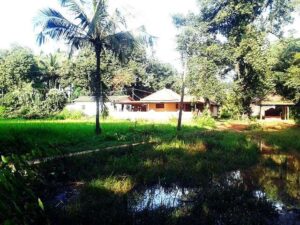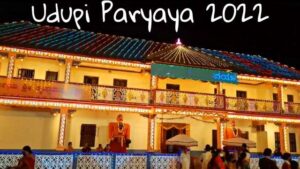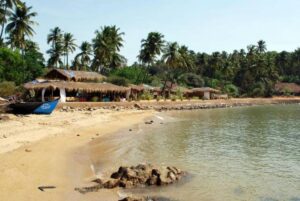Kunjarugiri is located in Kunajaru. Kunjaru is a hamlet in Kurkaal grama, situated 6-7 miles (approximately 11kms) to the southeast of Shri Krishna’s Udupi. This small village is reputed for its sanctity owing to the celebrated Durga Temple on a high hillock popularly known by the names: Kunjarugiri, Durgabetta and Vimanagiri. This potent Durga Saannidhya, which was installed by none other than Lord Parashurama. The high hills, abodes of Shri Durga and Lord Parashurama, look like “Kunjara” (Elephant) for which the place is known as “Kunjaragiri” or “Kunjarugiri”. It is also reputed as “Vimanagiri” because the Gods and Goddesses came by “Vimana” to offer floral tribute when Jaganmatha Durga was installed on the hill by the Lord Parashurama. The sacred association of Vishwaguru Shri Madhwacharya – gives it a prominent place in the spiritual sphere.
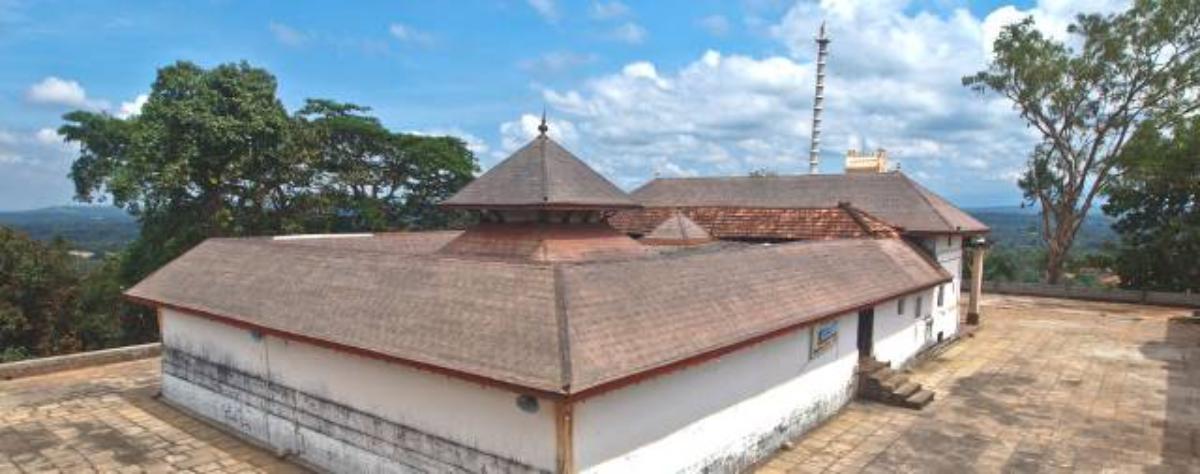
The ancient Durga Devi Temple stands on the top of Vimanagiri amidst the lush green groves of hilly serenity. This very serene location of the temple, its antiquity and the divinity of the magnificent idol of the Goddess, at once creates a memorable feeling of long-lasting devotion and piety in the hearts of the devotees. It has been the experience of every devotee who visits the temple for worship. The devotees feel the spiritual solace and the potent protection at the feet of Durga Devi. The holy atmosphere in and around the shrine, the holy Teertha’s, the Lord Parashurama Temple and the nearness to Pajaka Kshetra makes it an important place for the pilgrims.
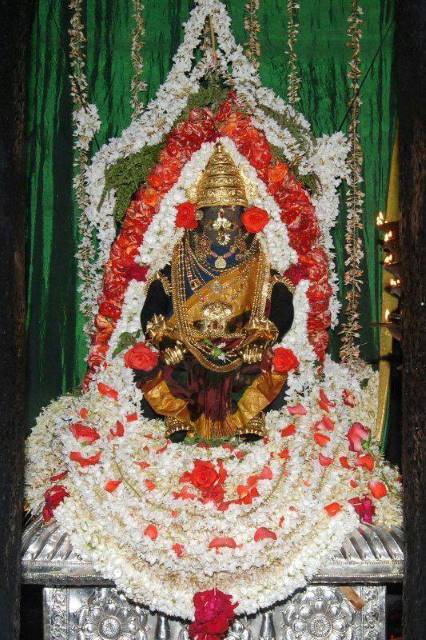
Page Contents
Yogamaya Rupa
Durga is one among the manifestations of Lakshmidevi. As Durga, She controls the tamo guna of the Prakriti (Primordial Matter and Nature). Under the command of the Lord, Durgadevi assumed the form of Yogamaya (Goddess presiding over Primordial Matter and Nature). In the Dwapara Yuga, when Lord Vishnu incarnated as Shree Krishna, the Yogamaya too manifested as Durga (as per the command of the Lord).
It was the Yogamaya who had transferred Shesha from the womb of Devaki to the womb of Rohini, facilitating the descent of the Lord (as Krishna). The same Yogamaya then manifested bearing the name Durga (as the baby of Yashoda) when Lord Krishna had incarnated as the son of Devaki. The Yogamaya (as the controller of the darkness and ignorance) had put the guards of Kamsa to sleep or a state of trance (when Vaasudeva manifested as Balakrishna in Kamsa’s prison) to facilitate the safe passage of Vasudeva (carrying Bala Krishna) towards the Nandavraja! She (Durga in the baby form) was brought (from Nandavraja) to Devaki by Vasudeva, replacing Krishna.
Presuming Her to be the eighth child of Devaki, Kamsa rushed to thrash Her against a rock! Escapingly, She sprang up to the sky! Assuming Her eight-armed cosmic form; warned Kamsa of his destruction, before She disappeared adding to the fears of Kamsa.
It is by this way Durga (a manifestation of Lakshmidevi) came to be known as “Hariswasa” or Hari’s sister (Krishna’s sister)! One can get into the sequence of this background from the readings of Srimad Bhagavata.
As per the lore and according to the tradition (belief) the Yogamaya [Goddess presiding over the wonderful divine potency for the creation, preservation and destruction of the Universe] resides as Durgadevi in Kunjarugiri. The great works like Sumadhwa Vijaya and Theerthaprabandha too refer to Durgadevi of Kunjaru as Krishna’s sister or Hari’s sister.
The significance in the idol (Vishwa Roopa Darshana)
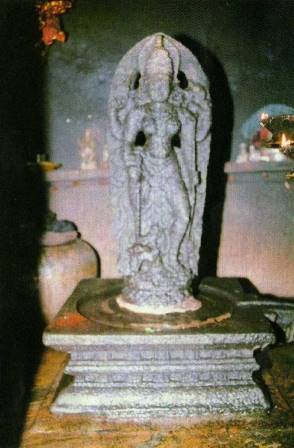
The magnificent idol of Shree Durga is a Chaturbhuja (four-armed) image. It stands holding the Shanka (conch) and Chakra (discus) in the upper hands and Dhanus (bow) and Trishula (trident) are being held in the lower hands.
Shanka and Chakra symbolize protection and the fulfillment of wishes of the good (sishta rakshana), while Dhanus and Trishula symbolize the destruction of the evil (dushta samhaara). The fallen Mahishasura stamped under the feet signifies the suppression and destruction of the evil .The horns on the head of the fallen demon Mahishasura represent the egotism in us! This makes us forget God. But the idol shows and symbolizes the destruction of such ego.
The majesty of the image lies in the facial features. The divine serenity of the ever-smiling face is a rare gesture found in the idol of Durgadevi during the act of asura samhaara (culling of demons)! This divine serenity signifies tranquility, peace and bliss.
In totality, the idol symbolizes the destruction of ahamkaara (resultant of tamoguna). The serene, blissful smile promises protection for the pious and good. It reassures a devotee of the blessings along with Jnana and Bhakti. Thus, the transcendental magnificence and grace of Durgadevi is reflected in idol at Kunjarugiri temple.
References in ancient literature
Great literary and historical works like Sumadhwa Vijaya (authored by Shri Narayana Panditacharya) and Theerthaprabandha of Shri Vadiraja Gurusarvabhoumaru are ancient works twhich eulogize and sing the praise of Shree Durgadevi of Vimanagiri. These ancient works give us factual details and required education to understand the significance of the Shrine.
Sumadhwa Vijaya (2-11) gives a detailed elaboration about the place while describing the significance of Pajaka Kshetra, the birthplace of Jagadguru Shri Madhwacharya. Sumadhwa Vijaya refers to the place as Vimanagiri, the abode of Lord Krishna’s sister Durga, installed by Lord Parashurama (the 6th incarnation of Lord Vishnu). Theerthaprabandha (Paschima prabandha 17.20) makes a mention to Durgadevi, who is ever residing on Vimanagiri in affection towards Her son Shri Madhwacharya. It further eulogizes Goddess Durga and extols Her as the Slayer of Mahishasura. It describes the Goddess as Thrishuladharini, the giver Swarga (Heaven) and the Moksha (Liberation) for the qualifying devotees. Durga, the destroyer of the evil, is extolled as the Divine Mother, Protector and Saviour of the good, who resides in the hearts of all living beings.
Theerthaprabandha also eulogizes Durga as unfathomable even to the Devas and the learned! Further, it mentions that She is ever inaccessible and unconquerable by the unrighteous, evil and wicked; hence the name Durga stands appropriate!
Apart from the above Sanskrit works, the Dasa Sahitya too makes a mention about the glory of this Kshetra, Shri Vijayadasaru has sung the glory of Lord Parashurama and Durga of Kunjarugiri. He has recorded the specialties of the Kshetra.
Installed by Lord Parashurama
The idol of Durgadevi was installed by the Supreme Lord Himself, even though it is quite unusual that a superior Lord installing a subordinate Deity. Lord Parashurama (incarnation of Lord Vishnu) is superior to Durga and precedes Her as Master. This unique feature too adds to the potency and significance of the Shrine.
Proximity to Jagannatha and Jagadguru
Temple and Pajaka Kshetra
To the west of the Durgalaya, there is a hill on which there is a temple dedicated to Lord Parashurama.
To the east (at the feet of Durgabetta) there is Pajaka- the birthplace of Trailokyaguru Shri Madhwacharya where the great Acharya spent his early childhood days with utmost devotion towards the Supreme Lord and the Goddess.
Thus, these unique features prominently symbolize the blessings of the Lord on the Goddess and also the Motherly affection and blessings of the Goddess towards Shri Madhwacharya.
Devotees can reach up to the temple from all directions of the hill. There are either steps or roads in all directions. The steps and road in the western side of the hill are familiarly used by the devotees.
About 1 KM to the east (at the feet of Durgabetta) there is PajakaKshethra – the birthplace of Trailokyaguru Shri Madhwacharya where the great Acharya spent his early childhood days with utmost devotion towards the Supreme Lord and the Goddess.
To the east of the temple, the Bottom of the temple, there is a place where daemon Manimantha was killed by Shri Madhwacharya.
Parashurama Kunjarugiri
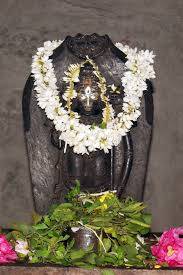
To the east of Durgabetta, there is Bana Theertha (arrow-shaped sacred pool created by Lord Parashurama) and the Gada Theertha (mace-shaped sacred pool created by Lord Parashurama) is to the west of the hill. These are the two Theerthas among the four theerthas created by Parashurama on the rocky terrain. The water of these Theerthas never dries up even during the hottest days of summer!
The Parashurama cave is located to the east of the temple on a slope terrain of Durgabetta, at a lower altitude than the temple. It is believed that there is the Divine presence, influence and saanidhya of Lord Parashurama even today. The four sacred Theerthas (Parashu Theertha, Dhanus Theertha, Bana Theertha and Gada Theertha) around the region, and the cave – all created by Lord Parashurama confirms the association of Lord Parashurama with this region.
Bana Theertha
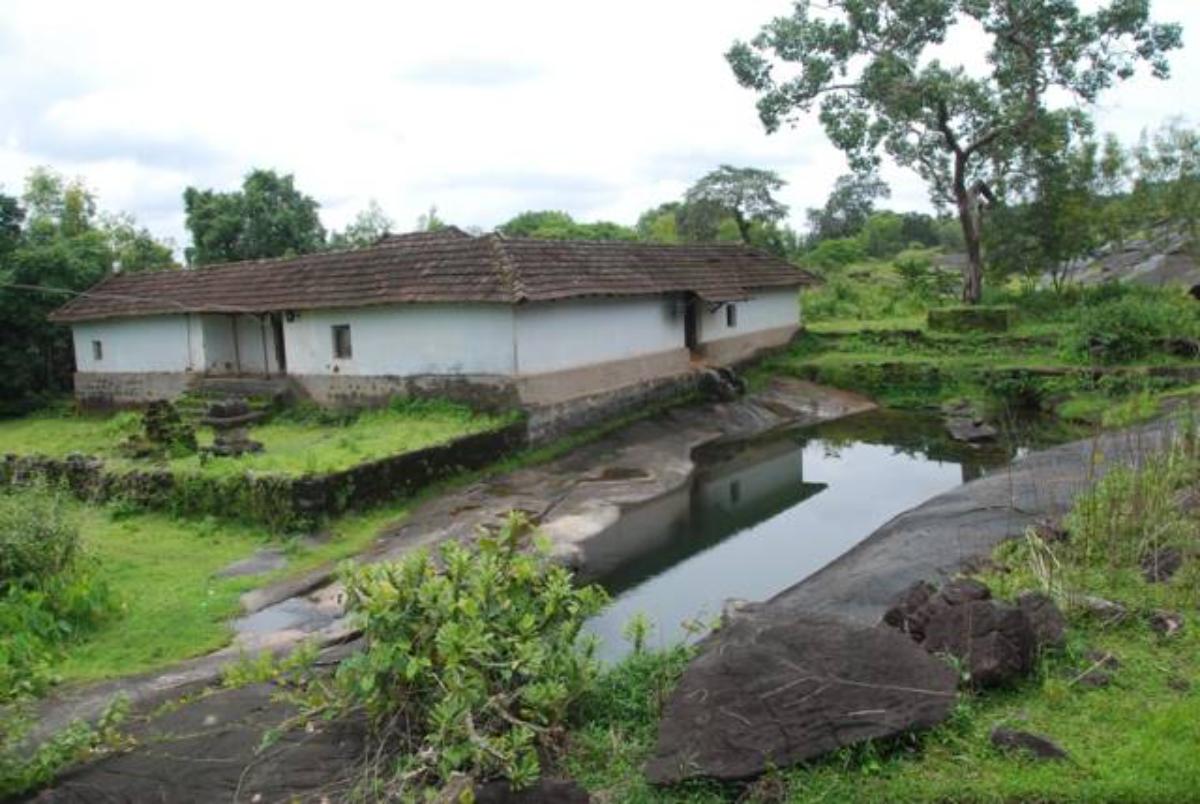
Gada Theertha
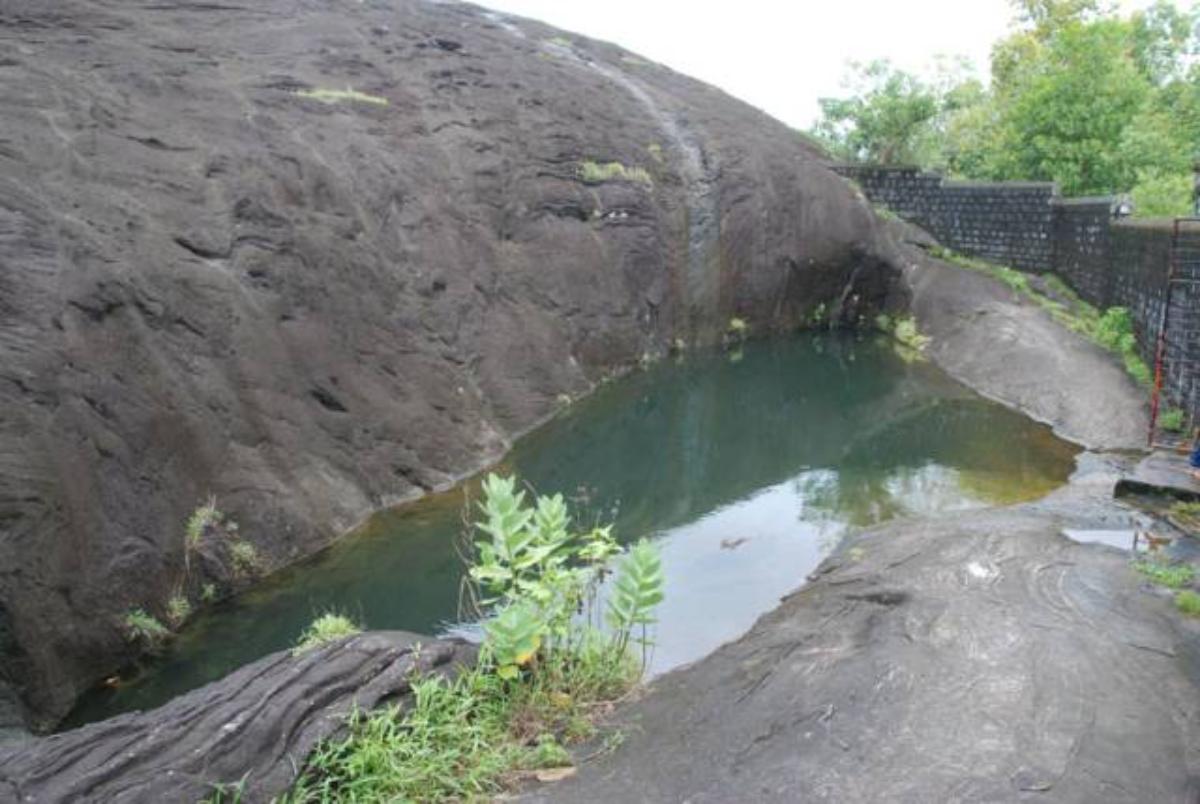
Parashu Theertha
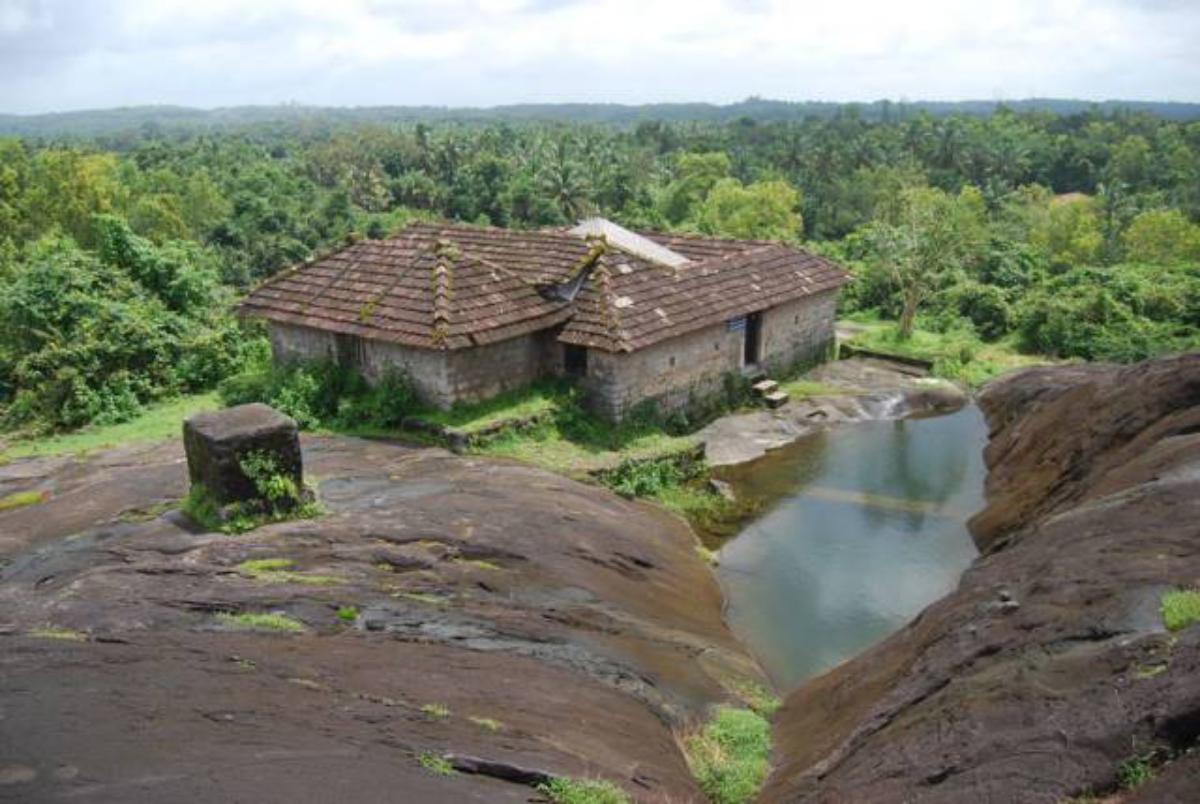
Dhanusu Theertha

Parashurama Cave Kunjarugiri
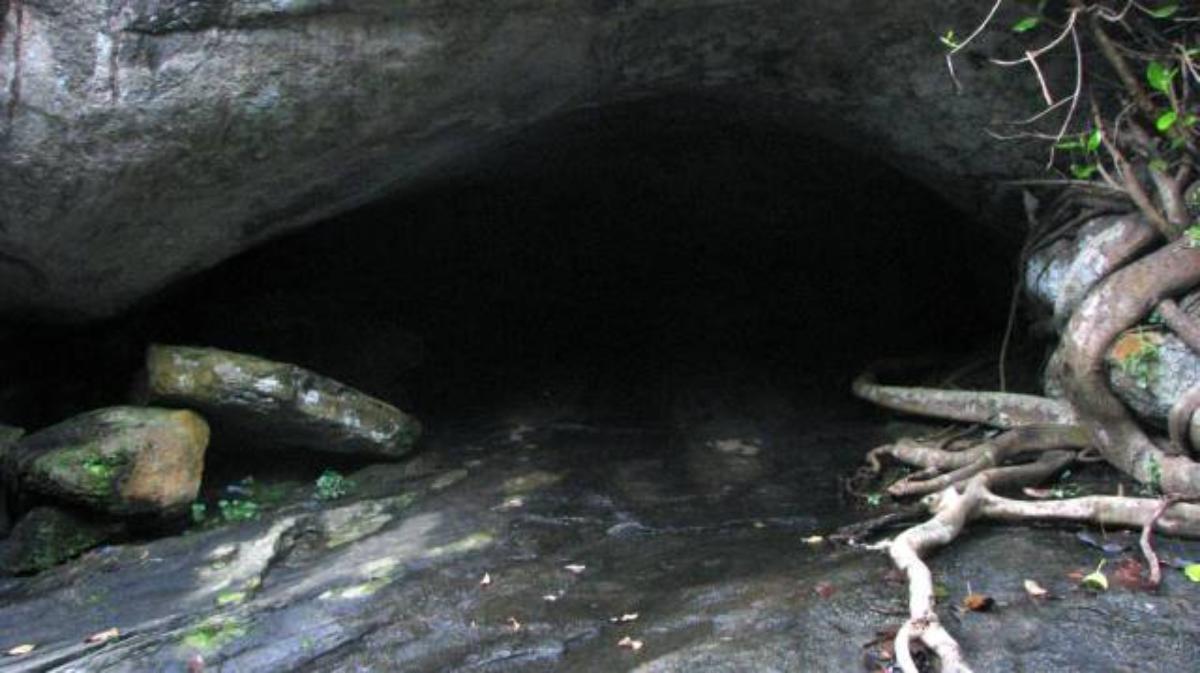
The height of glory
The temple is located at an altitude of more than a hundred feet above the surrounding land level. One has to tread over 257 steps to reach the temple. The name Durga (of the Goddess) holds appropriate as Her temple stands like a crown or jewel on the top of Vimanagiri; hence the Goddess is known to be Giridurga! She stands on the top of Vimanagiri as a Saviour and Guardian of the good. The topography of the place signals that the Saanidhya of the Goddess is accessible only to those who toil upstairs with faith and devotion.
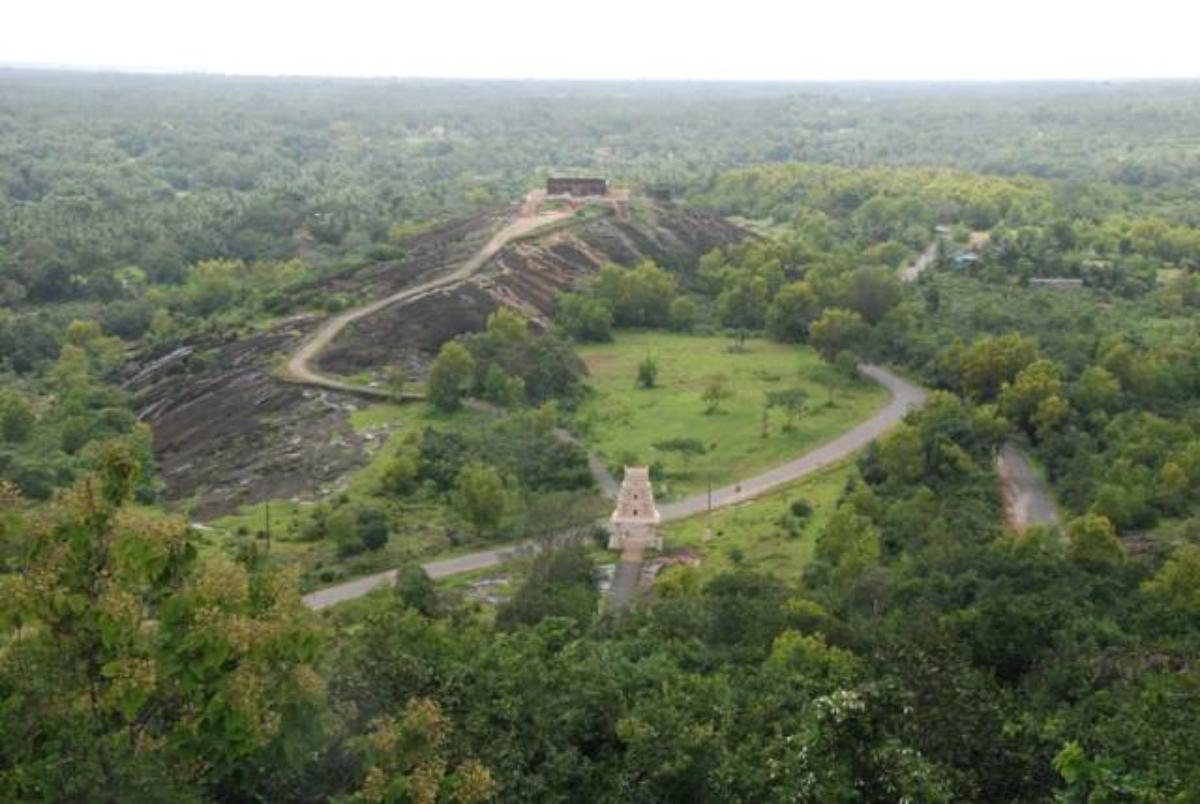

Serene atmosphere
One can experience and enjoy the rule of quietude and peace, amidst the lush greenery filled with melodious notes of singing birds including that of peacocks, the pranks of monkeys too add to the diversity found on the hill.
The blowing winds, rustling leaves add rhythm to the divine song of nature. Here everything appears as if they are singing the glory of the Goddess in meditative silence! The devotees can experience something Divine; as they feel the existence of the Divine Mercy of the Goddess. Durgadevi is also known to be residing here as Vanadurga.
The waves of the Western sea (Arabian Sea) are clearly visible from the temple precincts. One can watch the reflection of the sea during the daytime and also watch the sunset during the evening. Whenever the sky is clear, one can have a memorable experience of the sunset in the background of the golden sea and the orange horizon!
The movement of the clouds, the scenery, the sunset, the picturesque appearances during the dawn and dusk, the greenery, the hills and rocks, the flora and fauna, the wind, the pleasant breeze, the buzz and even the silence add to the divinity of the place.
A glimpse of the Goddess from outer yard
The architecture of Durgalaya is ancient and special. One can easily have the darshan of the Goddess from the outer yard (horangana) itself. The inner yard of the temple is about three feet higher than the outer yard. The Sanctum sanctorum (Garbha-griha) including the pedestal on which the idol has been installed, is about three feet higher than the inner court. This enables the devotees to have easy darshan of the Deity even from the outer yard of the temple.
Idol of Nirmalya Devata
In the praakaara, to the left side of Devi, the idol of the Nirmalya Devata ‘Mundini’ has been installed. Generally, the Nirmalya Devata is represented by a plain stone in all the temples. The Durgalaya of Kunjar is an exception to this, as one may see the idol of the Nirmalya Devata in the sitting posture.
Carrying water uphill
Owing to its high altitude, Durgalaya has got no natural source of water in its premises. Water has to be inevitably fetched from the Bana Theertha or Gada Theertha down the hill. Pot full of water has to be carried uphill (upstairs) with utmost purity for the worship. More than six large pots of water are required for the daily rituals. Water fetched in the unusually-large copper pot is carried upon the head uphill. It takes more than eight minutes for an experienced person to carry a pot full of water to the temple.
Management and worship
The administration and management of the temple belong to Sri Admaru Matha, Udupi. The traditional and spiritual relationship of the Durgalaya with the Matha is reflected by a custom observed on a night during the Sharannavaratri celebrations. The Swamiji of Sri Admaru Matha brings the Presiding Deity of the Matha to the temple and offers the Mahapuja to Shree Kaliyamardana Krishna Devaru (Presiding Deity of the Matha). The idol of Shree Krishna is then kept in ‘Ekanta’ along with Durgadevi in the Sanctum, symbolizing the Divine union.
The relationship of the Matha with the Durgalaya is also reflected in the patterns of daily worship, rituals and the festivals which are in practice here. The Archakas (Priests), the Keelu Shanti (who prepares the Naivedyam) and the Udaka Shanti (who brings water for worship) strictly follow the purity and fast up to the completion of Mahapuja. Every ritual is offered to the Goddess with the chintanam of Durgaantaryami Lakshmi Narayana.
The pujas and rituals are traditionally performed by the Priests who belong to the two families of the Kunjithayas, in a fortnightly rotation. Priests are enjoined to keep within the temple precincts and observe celibacy when they are in charge of the daily worship.
Daily Pujas
The day begins with the performance of Nirmalya Visarjana Puja during the dawn at
5:00 AM. This is followed by the Ushakaala Puja. After decorating the Idol, the Alankara Puja is performed at 8:00 AM. Naivedya is offered during the Ushakaala Puja and Alankara Pujas. The Maha Puja is performed at 9:00 AM and Naivedya along the rice paayasam is offered to the Goddess during the Mahapuja. The Raatri Puja is offered after sunset at 7:30 PM.
Annual Festivals
Annual rituals and festivals are observed with great devotion and fervour according to the time–honoured Customs.
Sharannavaratri is an important festival celebrated here. Navadurga Kalpoktha Puja is performed during the days of Navaratri. The Kannika Puja, a speciality of the Durga Temple, is offered in a grand scale. Kannika Puja is offered by the devotees as an important Seva at the temple. Many people visit this temple during Navaratri and offer their prayer at the feet of the Goddess.

During the Fridays, in the month of Simha (Simha Maasa), thousands of devotees come here to have the Holy Darshan of the Goddess and offer their sevas.
The Rathotsavam (Annual Car festival / Chariot festival) is held in a grand scale with devotion. The rituals during the Uthsava are very elaborate and have their own special features. The Dhwajaarohanam is performed on the Maagha Shuddha Trayodashi day. The Rathotsavam is celebrated on Maagha Shuddha Poornima day. Feasting (Maha – Annasantharpane) is held on this day and thousands of devotees participate in it to take Prasadam. Many people also gather near the Shrine to witness the spectacular Rathotsavam on that night.
The annual ritual of ‘Rashi Puja’ is performed during the Amavasya (New moon day) following the Rathothsava. Many devotees participate in this ritual and offer their prayers to the Goddess.
On the eve of Sowramana Yugadi ‘Kani’ is kept here and ‘Panchangashravana’ is done on the Sowramana Yugadi day in the morning. Ganapathi Homa is performed during the Ganesha Chaturthi and the Krishnaashtami is specially celebrated by offering special pujas to mark the occasion.
Dhanur Puja is offered during the Dhanurmasa and Paschimajagara Puja is offered in the month of Karthika. Both Pujas are offered at the dawn during the respective months. Apart from the above festivals and rituals, Rugupakarma is also observed here.
The extent
The Durgalaya of Kunjaru is known to be the Presiding Temple of the ‘Bali Saagara Maagane’. The people spread across the twelve Maaganes worship the Goddess as their Presiding Deity. Each Maagane is a group of villages and the extent of the temple spreading up to twelve such Maaganes shows its Antiquity and Precedence in this region.
The people from Kannaraadi, Undaaru, Innanje, Kalmanje, Palli, Belle, Biliyaaru, Paaje, Kurkaalu and the adjacent areas are the traditional devotees and the followers of the temple. The devotees from these areas regularly visit the temple for worship. Special samaradhane is offered to Durgadevi of Kunjaru whenever the Bhuta kolas are to be performed in the villages like Acchada, Biliyaaru, Belle, Edaneeru, Paaje and Kurkaalu.
Durgadevi of Kunjarugiri (installed by Lord Parashurama) is the Kuladevata for the descendants of Jamadagni Gotra. The ‘Aithals’, ‘Adigas’, ‘Shastris’, ‘Somayajis’ of Kundapura too worship the Goddess as their Kuladevata.
Apart from this, most of the pilgrims visiting Udupi Shree Krishna Matha come here to have Darshana of the Goddess on Kunjarugiri. The Swamijis of AshTha Mathas visit the Durgalaya and Worship the Goddess before ascending the Paryaya PeeTham at Shree Krishna Matha, Udupi. Thus, Kunjaru is revered as a Theertha Kshetra and is considered as an important place for pilgrimage.

